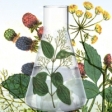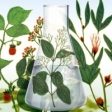Absinth
Absinth is a distillate equipped with a high alcoholic graduation made of anise aroma coming from herbs such as absinth flowers and leaves (Artemisia absinthium), from which the name derives. By considering its usual green colour (naturally or through the use of artificial dyes ), absinth establishes itself through Fée Verte (Fata Verde). It is generally drunk by adding iced water and/or sugar. This kind of preparation makes the distillate more cloudy for its consistence and lighter for its alcoholic graduation by giving a better flavour during the tasting. This was the way people used to taste in 1800, the famous century with the maximum absinth spreading. Absinth is indeed well-known, especially because of Parisian writers and artisans association during Decadentism; it met its popularity in France at the end of that century and at the beginning of the following one until its prohibition in 1915. Pernod Fils was the most well-known absinth brand in the world. Absinth looks colourless or made of all clorophyll nuances, from light yellow colour to emerald green one with a complex flavour due to a perfect aroma and herb balancing. In addition to absinth leaves, it contains green anise seeds (starry anise, often found in its surrogates, and when rarely used, in small quantities), fennel seeds, hyssop, melissa, artemisia pontica and other different ingredients that changed from distillery to distillery such as angelica, mint, genepi, camomile, coriander. It could be a thesis with no foundation, but in the nineteenth century absinth was used as drug, so adulterated with opium: there is no historical document confirming this and no receipt talking about it. Absinth is a product for soaking and direct distillation of ingredients. Consequently, when right, it is tinged through a further herb soaking including artemisia pontica, hyssop and melissa. A cheaper variety of this drink is made of essences or cold mixing oils in alcohol. The alcoholic content is extremely high in order to allow clorophyll to be steady for longtime (between 45% and 75%).













